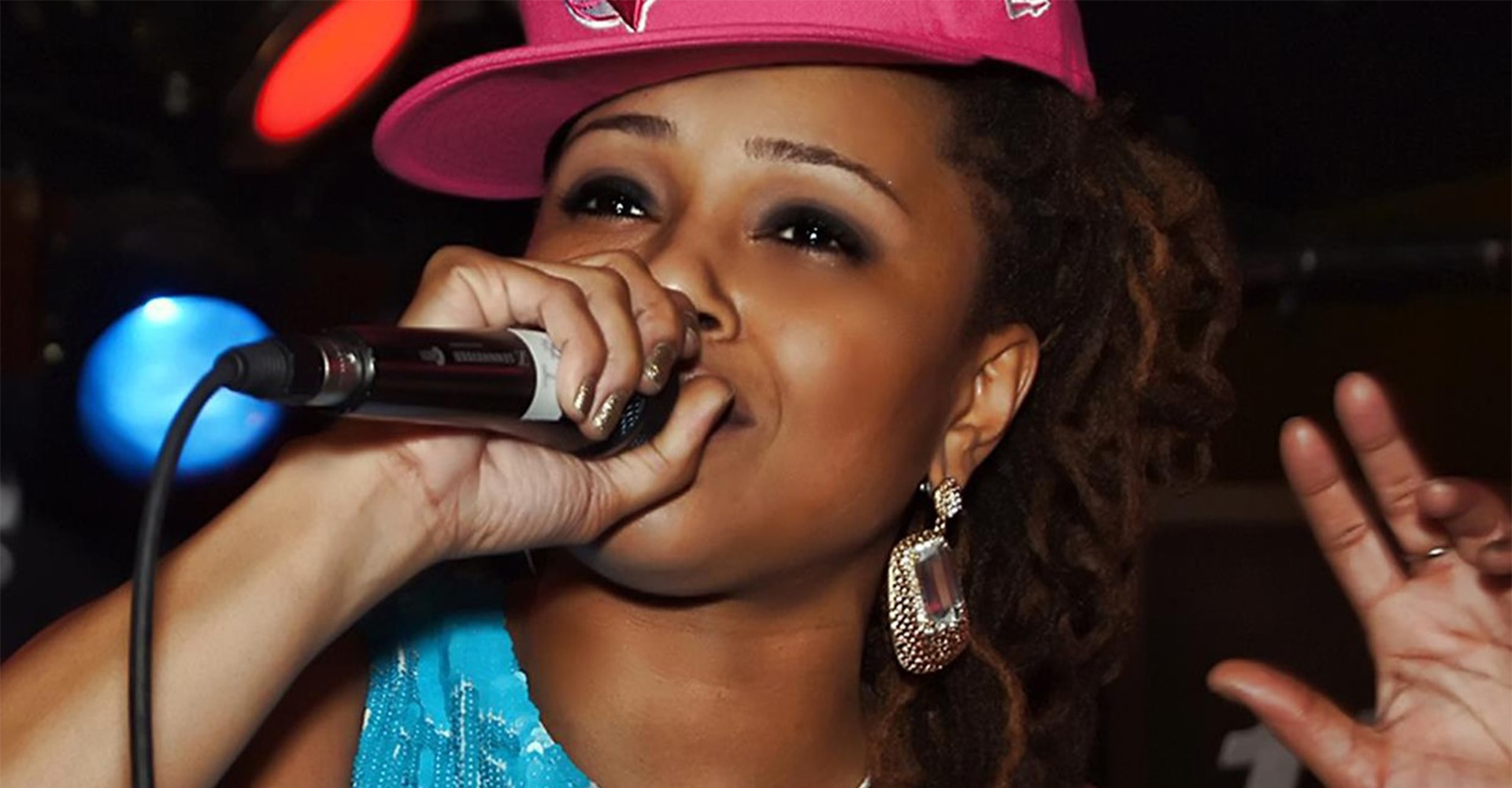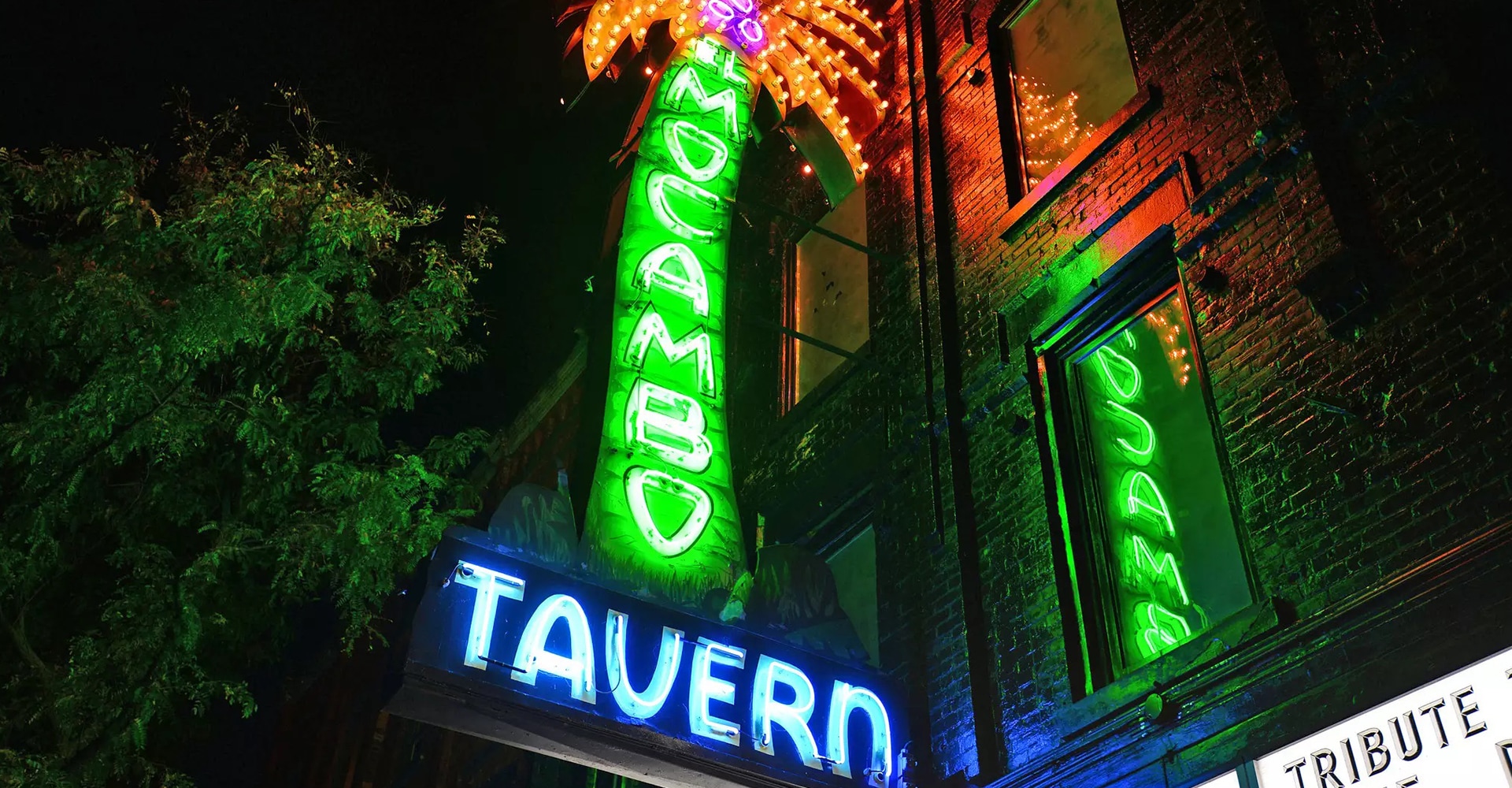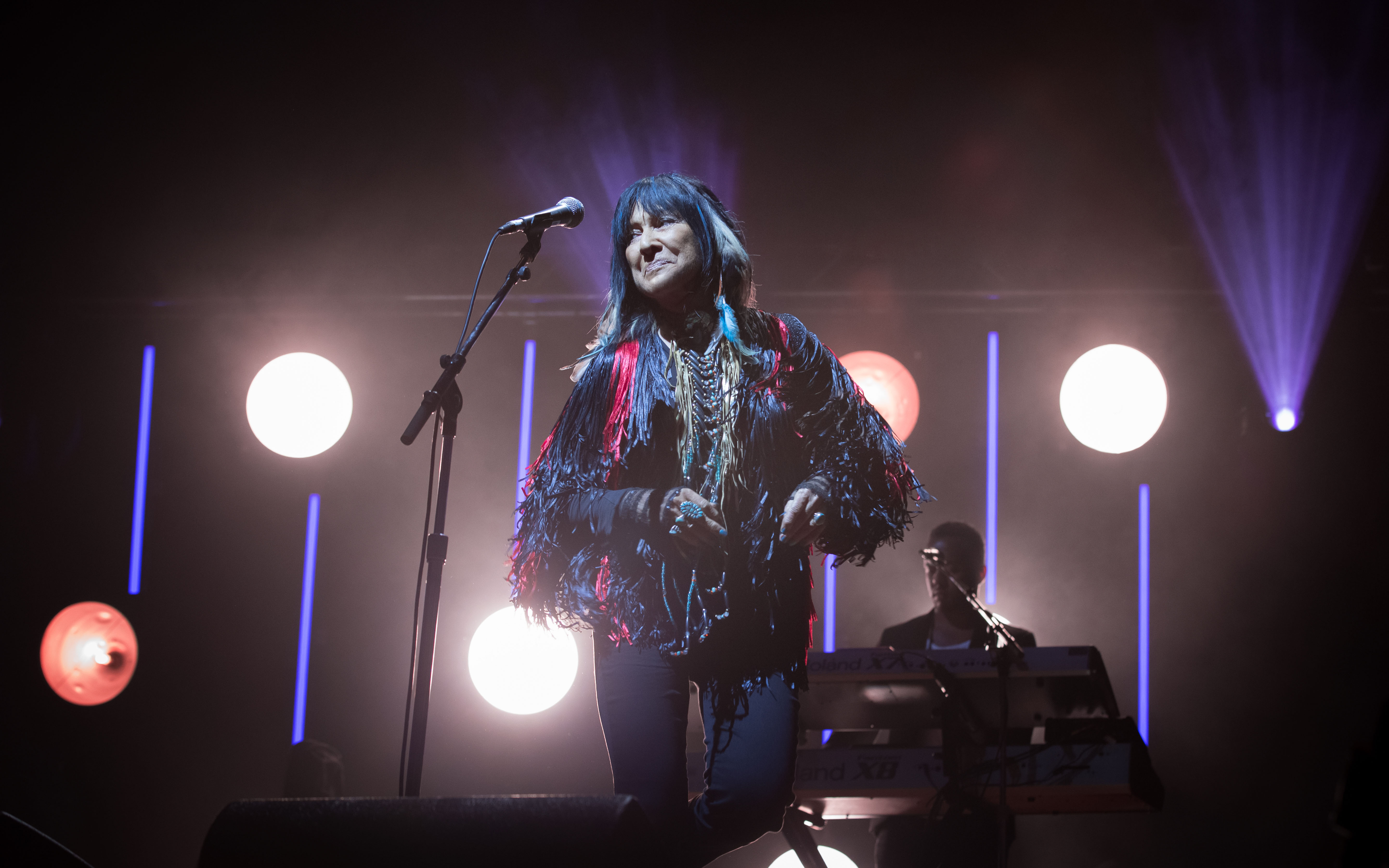
Before the rise of online streaming, where you can watch your favourite YouTube stars or listen to music on your mobile device at any time, we had to wait for our favourite song to play on the radio, or for a Video Jockey (VJ) to announce the latest music video. MuchMusic, "the nation's music station," brought music and Canadian pop culture into our homes and onto our televisions, connecting Canadians through a shared experience of music made visual.
Since the 1980s, music videos have provided a platform for both emerging and estalished artists to give a permanent visual narrative to their work. From Michael Jackson's "Thriller" to Drake's "Hotline Bling", they have become an essential part of the way that we consume music. As one of the world's biggest search engines, YouTube has only expanded our ability to watch them.
Music on Television
MuchMusic launched on Canadian television on August 31, 1984. Founded by John Martin and Moses Znaimer and part of media group CHUM Limited, the channel was the first in Canada to be solely dedicated to music programming.
MuchMusic was originally a paid subscription channel, one of the few specialty channels available to Canadian audiences in the 1980s. It took four years for the station to become part of basic cable, and since then, music in Canada has never looked quite the same.
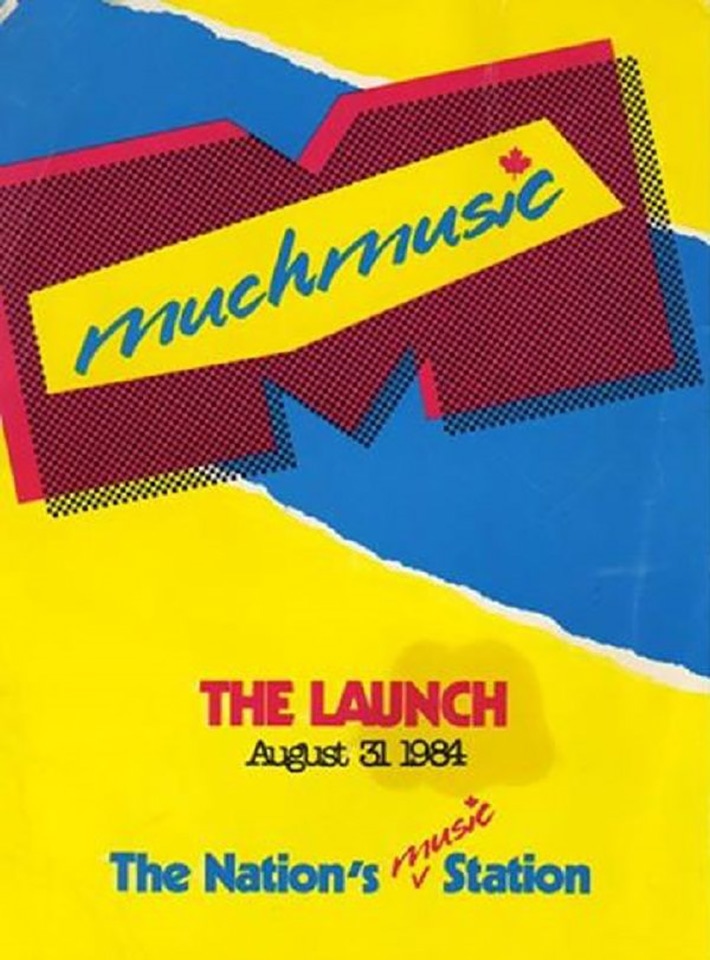
MuchMusic launched with this bold coloured poster on August 31, 1984.
Courtesy of Ed Conroy, Retrontario.
Watch: MuchMusic's Early Days
Watch the opening sequence of MuchMusic for its 1984 debut on Canadian television.
This online exhibition uses third-party applications including Spotify and YouTube. Check with your organization’s web administrator if you are unable to access content from these channels in the exhibition.

Courtesy of Ed Conroy, Retrontario. Please note: this third-party video does not provide closed captions.
View Transcript[music playing]
Voice-over: 24 hours a day in stereo, this is the nation's music station...Muchmusic.
Tonight, live from coast to coast, the launch of Canada's first 24-hour music channel. The nation's music station, Muchmusic.
Featuring the world video premiere of Rush - the Enemy Within - and The Spoons' Tell No Lies. Plus, the Canadian video premiere of Yes, Elvis Costello, The Fix, Human League, Slaves, Culture Club and a few surprises.
[Two men punch through a backdrop and walk through. One wears a plaid shirt, the other a shirt and blazer.]
- Let's get on with it here, alright, alright. Heck of a way to start a rock and roll show!
- That's a little bit of a snappy opening, isn't it?
- Yeah, I think so.
- I'm JD Roberts.
-I'm Christopher Ward, and what we have for you to kick the whole thing off is the first time that music and picture were ever synced.
- This is from 1922 and Eubie Blake this Snappy Song...
Both: On MuchMusic!
[Cut to shot of audience watching a big screen]
The First Music Videos
In 1984, playing music on television was a new phenomenon. MTV had debuted in the United States only three years earlier, in 1981. Music videos were a brand-new genre and still relatively rare. When MuchMusic debuted in 1984, the first music video to be shown on the channel was by Toronto rock band, Rush for their song “The Enemy Within.”
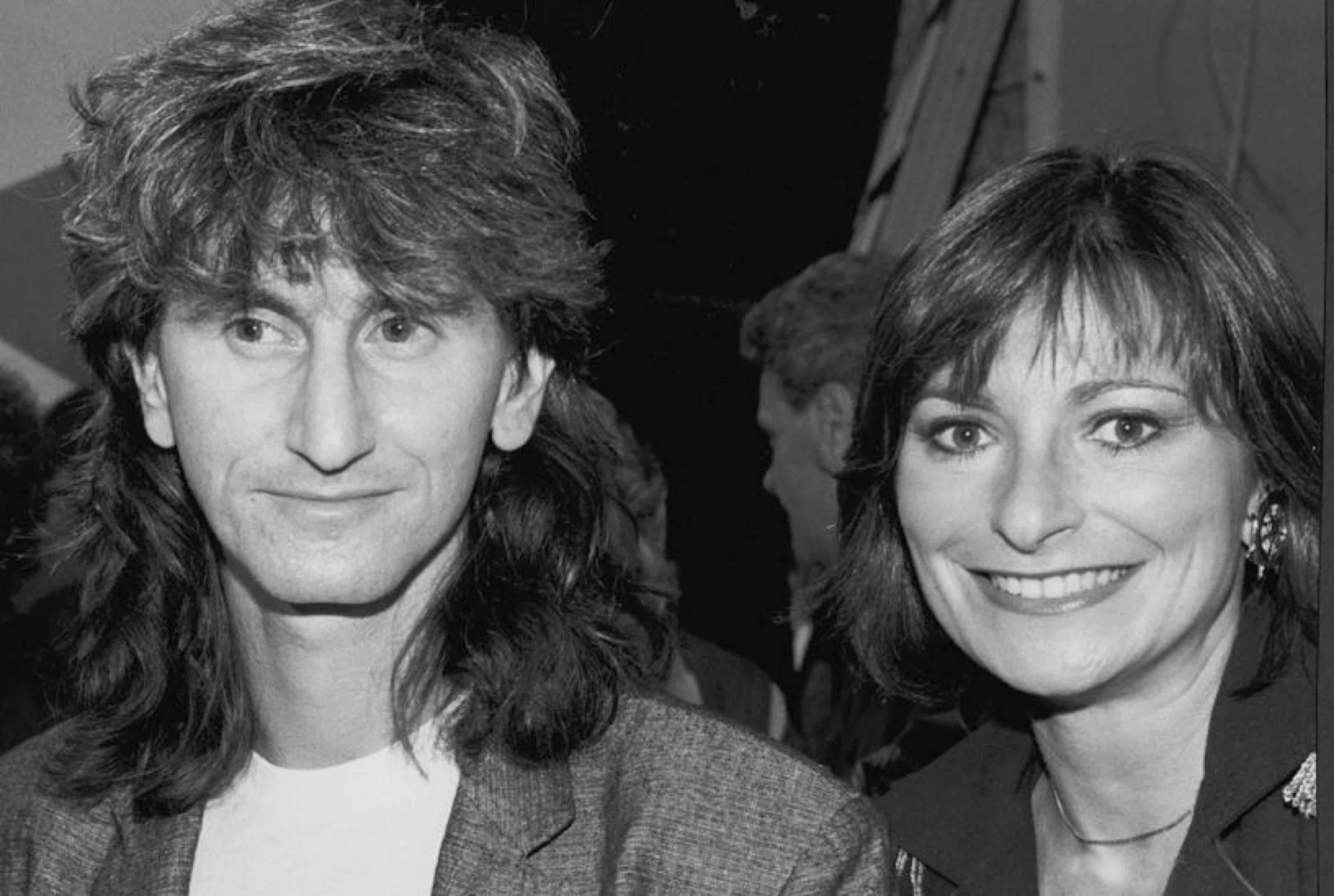
Photograph by Dimo Safari. Courtesy of Library and Archives Canada, R14163-0-1-E.
The media company behind MuchMusic, CHUM Limited, also funded over 800 music videos in its first decade, by setting aside 5% of the station’s revenues. Through a foundation called MuchFACT (Foundation to Assist Canadian Talent on Video), the company gave Canadian talent the chance to become household names through videos broadcast on MuchMusic or MTV.
The funding program, which ran from 1984 to 2017, helped Canadian artists like Blue Rodeo and Celine Dion finance music videos during their early career. During the 2000s, the program funded videos by Carly Rae Jepsen and Arcade Fire. By the time the program was cancelled, it had given more than $100 million to 9,000 projects.
Watch: Rush's The Enemy Within
Watch "The Enemy Within", the first-ever music video to be broadcast on the MuchMusic channel. Written and performed by the Toronto rock band Rush and featured on their 1984 Grace Under Pressure album, the video's themes reflects the band's increasing use of electronic sounds, such as synthesizers. The video's futuristic tone and technological themes also matched the beginning of the music video era on television.
This online exhibition uses third-party applications including Spotify and YouTube. Check with your organization’s web administrator if you are unable to access content from these channels in the exhibition.

Music: Geddy Lee and Alex Lifeson; Lyrics: Neil Peart. Please note: this third-party video does not provide closed captions.
View TranscriptThings crawl in the darkness
That imagination spins
Needles at your nerve ends
Crawl like spiders on your skin
Pounding in your temples
And a surge of adrenaline
Every muscle tense to fence the enemy within
I'm not giving in to security under pressure
I'm not missing out on the promise of adventure
I'm not giving up on implausible dreams
Experience to extremes
Experience to extremes
Suspicious-looking stranger
Flashes you a dangerous grin
Shadows across your window
Was it only trees in the wind?
Every breath a static charge
A tongue that tastes like tin
Steely-eyed outside to hide the enemy within
I'm not giving in to security under pressure
I'm not missing out on the promise of adventure
I'm not giving up on implausible dreams
Experience to extremes
Experience…
MuchMusic Studios
Although thousands of music fans have stood outside the headquarters at 299 Queen Street West over the years, the channel was first based several blocks east, a former dance club called Electric Circus.
MuchMusic later took that club’s name for its live music dance show that ran from 1988 to 2003. The "Electric Circus" show featured artists, celebrities, and fans who made their way to Toronto, to be part of the scene and to be seen on TV.
Located on the ground floor and surrounded by glass windows, the MuchMusic studio on Queen Street West invited pedestrians on the street to catch a glimpse of the show inside. Studio audiences often spilled over into the streets, braving the weather. Celebrities would go outside to greet their fans before or after a studio taping.
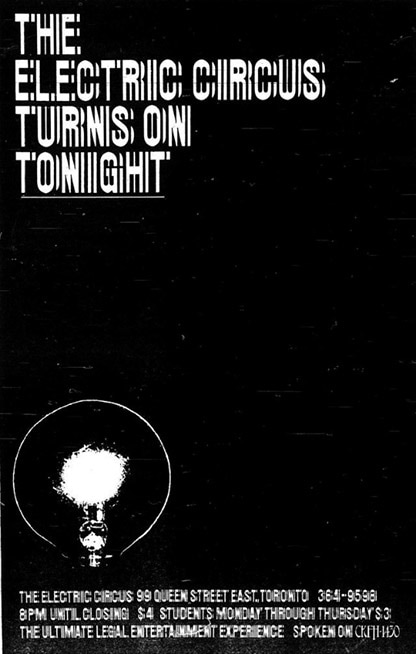
Before it was a live dance TV show, Electric Circus was a dance club at 99 Queen Street East. Opening poster from December 21, 1968.
Courtesy of the Toronto Telegram.
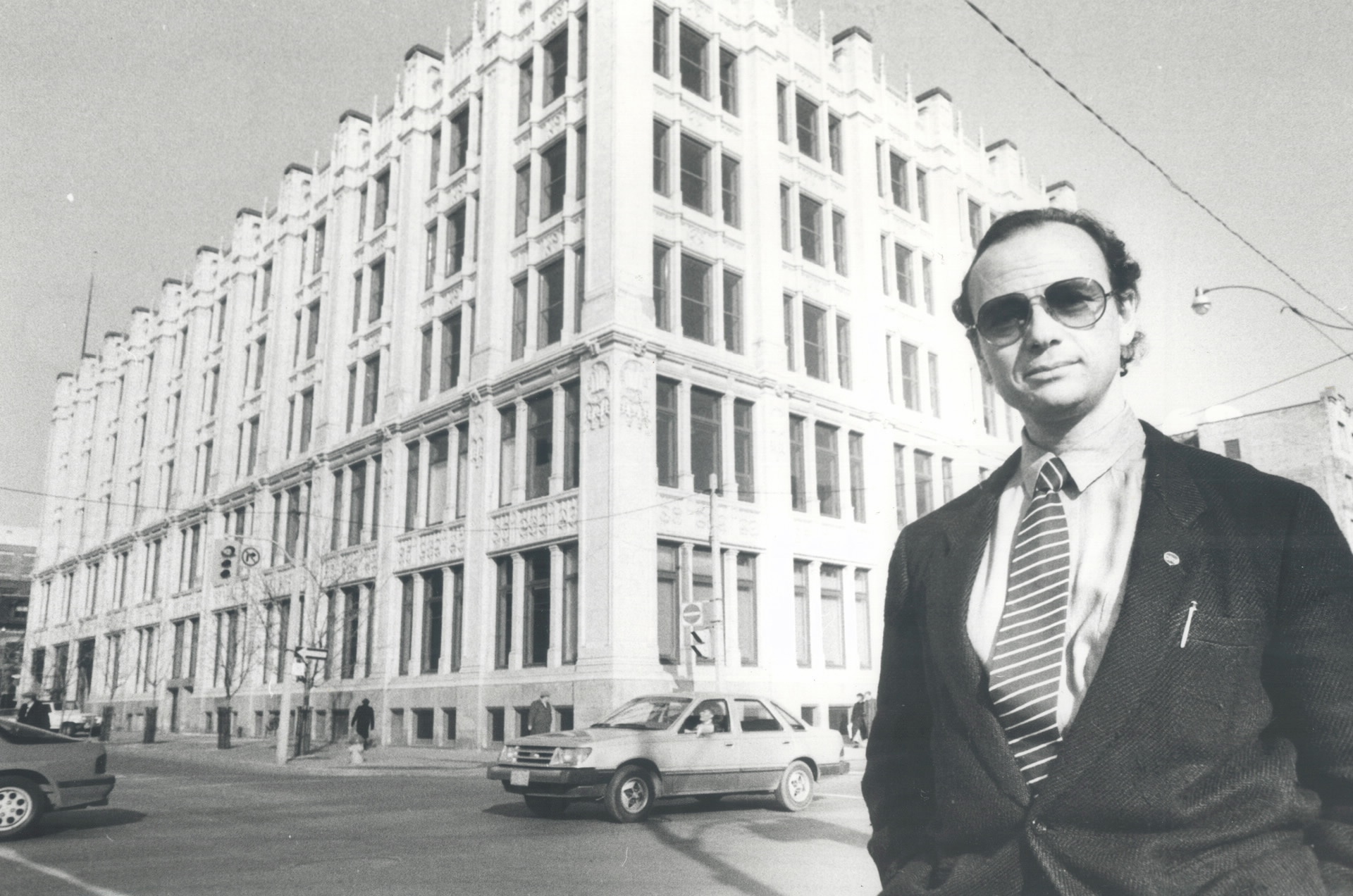
Head of Citytv and MuchMusic Moses Znaimer stands outside of the broadcaster's headquarters on Queen Street West, 1987.
Photograph by Doug Griffin, courtesy of Toronto Star Photo Archives.
Video Jockeys
MuchMusic’s original VJs (video jockeys) celebrated creativity, having fun, and being in the moment. They included J.D. Roberts, Erica Ehm, Michael Williams, Christopher Ward, and Jeanne Beker.
MuchMusic’s co-founder Moses Znaimer saw both value and opportunity in hiring culturally diverse talent. He believed that the multiculturalism of Toronto should be reflected in the city’s broadcasters. This created a sense of familiarity with the MuchMusic VJs, as young viewers were able to see themselves reflected on their favourite channel.
The MuchMusic VJs also created a level of intimacy by speaking right into the cameras, reading screen notes, showing a bit of vulnerability by making mistakes, and moving around the station in the moment, all while keeping the live footage rolling. Anything could happen, and it often did.
The reality is, people only really care about the music. It's always about the music.
— George Stroumboulopoulos, MuchMusic VJ
Watch: MuchMusic's 15th Anniversary
Watch George Stroumboulopoulos celebrate MuchMusic's 15th anniversary back in 1999. In the background is the MuchMusic building still found today at 299 Queen Street West.
The building hosted numerous shows and programs associated with MuchMusic, including the annual MuchMusic Awards, which brought thousands of fans to watch their favourite artists receive awards. The building was also credited with revitalizing culture and business on Queen Street West, as Ontario Association of Architects president Toon Dressen commented, "What would Queen West be like today, what would the Canadian music scene be like today, without 299 Queen West?"
This online exhibition uses third-party applications including Spotify and YouTube. Check with your organization’s web administrator if you are unable to access content from these channels in the exhibition.

Courtesy of Ed Conroy, Retrontario. Please note: this third-party video does not provide closed captions.
View Transcript[Exterior of Citytv building in Toronto, pan to street and man with mic talking to camera. People standing or walking by behind him.]
Alright! August 31st 1984 is the date that's going to live in infamy because that's the date that MuchMusic actually signed on the air, I mean initially they played some sort of artsy music thing but the first real video they played [Split screen with Rush music video on the left.] was from Rush, "The Enemy Within" was the video.
And I remembered it clearly because we all tried to find one rich kid in the neighborhood who actually had cable, [Split screen ends, return to man on street] yes, that's right, cable. Remember that?
And we raced over to watch MuchMusic and it's been a busy time since that a couple of years later in '86, Music Plus signed on, the French language MuchMusic in Quebec. Since that time in the 90s you had USA, you had a signing on in Finland and as well in Buenos Aires and of course in the 2000s it signed on as MuchMusic Malaysia.
Now all of that's fine and dandy but the reality is people only really care about the music. It's always about the music, it's always been about the performances, [man points to Citytv building behind him.] and in its time this building has seen its share of beauties. [Zoom in on building.]
MuchMusic as a Powerful Youth Movement
MuchMusic’s programs like “Soul in the City” and “RapCity” brought many new artists and diverse music genres to a national Canadian audience. VJ Michael Williams lobbied to get programs that featured soul and rap music on the air with the help of MuchMusic producer Michele Geister. The programs were among the first of their kind to have a national audience.
Michele and others wanted to make sure they were educating youth across Canada about all the elements of hip hop - its producers, MCs, dancers, graffiti artists, and managers. "RapCity" helped launch the careers of Michie Mee, Dream Warriors, and Maestro Fresh-Wes, while also attracting many emerging artists in the Toronto hip hop scene.
I felt strongly that this urban music
— Michele Geister, RapCity Producer for MuchMusic
was more than entertainment, it was an essential cultural expression for a community whose voice and expression was limited in the mainstream.
Soul in the City
MuchMusic and its parent station, CityTV, were known for the sign-offs of its on-air personalities. Listen to Michael Williams sign off on an all-request edition of Soul in the City.
This online exhibition uses third-party applications including Spotify and YouTube. Check with your organization’s web administrator if you are unable to access content from these channels in the exhibition.

Courtesy of Ed Conroy, Retrontario. Please note: this third-party video does not provide closed captions.
View Transcript[MuchMusic Logo over video of man dancing around dimly lit studio office. Fade to black.]
[Fade in to a close up of a black man in a suit talking to camera, behind him is a backdrop with "Soul in the City" on it. As he continues to talk, the camera zooms out to a full body shot.]
Thank you for joining us on this all request edition of Soul in The City, Michael Williams here with you. In the weeks to come we have a special guest co-host Shanice Wilson, and next week out of the UK, yes, The Brand New Heavies, they'll be right here with us on the set and the scene. Take good care of yourself and in the month of February, don't forget, Black History Month. Time for you to learn about yourself and to learn about a friend. Events will be happening all over the nation, we'll list them, we hope that you participate.
Speakers Corner
Speakers Corner first aired on CityTV in 1990, with the tagline "Speak. Speak and be heard."
Originally intended as a “letters to the editor” segment for news broadcasts, it quickly became popular outside of this concept. The video booth recorded up to 60-seconds of footage: music videos, actor auditions, and comedy skits were all submitted.
The 18-year series of short, self-directed segments foreshadowed Snapchat, TikTok, and the viral video revolution. Barenaked Ladies got their breakthrough playing "Be My Yoko Ono" in an early episode before a show at the nearby Rivoli bar in 1991.
This online exhibition uses third-party applications including Spotify and YouTube. Check with your organization’s web administrator if you are unable to access content from these channels in the exhibition.
We were the guys [who] crammed into Speaker’s Corner, popped in a dollar and essentially made a music video.— Ed Robertson, Barenaked Ladies
Watch: Speakers Corner
Do you remember what it was like to record your thoughts on Speakers Corner? Watch this 1991 advertisement encouraging you to drop by former MuchMusic headquarters to speak your mind.
This online exhibition uses third-party applications including Spotify and YouTube. Check with your organization’s web administrator if you are unable to access content from these channels in the exhibition.

Courtesy of Ed Conroy, Retrontario. Please note: This third-party video does not have closed captioning.
View Transcript♪ Rock music plays in background. ♪
(Spanning the sidewalk of MuchMusic building towards Speakers Corner booth at the corner of Queen Street West and John Street on a sunny summer day.)
A male's announcer voice begins with, "And now from the video booth at MuchMusic national headquarters, it is time for you to have your say on Speakers Corner."
♪ Rock music plays in background, and women's voices start singing inaudible words. ♪
(The video zooms into Speakers Corner booth and shows a hand putting a loonie into the slot. Pans to the Speakers Corner screen showing a digital red numbered countdown from 2, 1, flashing to "You're On" with a yellow background.)
♪ The music stops and the sounds of static plays briefly as the screen fades to black and white static on a TV to mimic a director's cut. ♪
♪ Rock music begins to play again in background. ♪
The video cuts to a streetcar driving by MuchMusic with the announcer saying,
"Next time you are in the Toronto area visit MuchMusic at Queen and John Street to speak your mind on Speakers Corner open 24-hours a day. It only costs a dollar and all money goes to charity.
(The video begins to pan the street corner showing the street signs and crossing light signal, then moves back towards the video booth where three young people are waiting for their turn in line, before panning towards a hot dog vendor at the corner. Youth and young adults walk by the building.)
The Speakers Corner Box
Before you could record and share video on your phone, how might you have gotten your voice heard? For only a loonie, Torontonians and visitors alike would line up and wait their turn to record their 60 seconds of fame.
First located at MuchMusic headquarters, Speakers Corner boxes could be found in most major Canadian cities in the late 1990s and early 2000s. The original prototype for the Speakers Corner box is now part of the MZTV Museum collection in Toronto's Liberty Village.
This online exhibition uses third-party applications that may not be compatible with your current version of browser. Check with your organization’s web administrator if you are unable to access content from these channels in the exhibition, or try to access this webpage from another browser.
Keyboard controls: Use arrow keys to rotate the object and page up/page down to zoom.
Step inside and get a sense of what it was like to record a Speakers Corner video. Courtesy of the MZTV Museum of Television and Archive. Digital rendering commissioned by Heritage Toronto.
From 1990 to 2008, this was Speakers Corner. This was where citizens could voice their opinion on political issues or new talent could show off their skills to the nation.
Actors Mike Myers and Scott Speedman got their start with a clip from the Corner, and Canada's 20th Prime Minister, Jean Chrétien, got out the vote in 2000.
Today, the familiar building is owned by Bell Media, which acquired MuchMusic in 2007. Outside, the commemorative "Moses Znaimer Way" pays homage to the channel's founder.
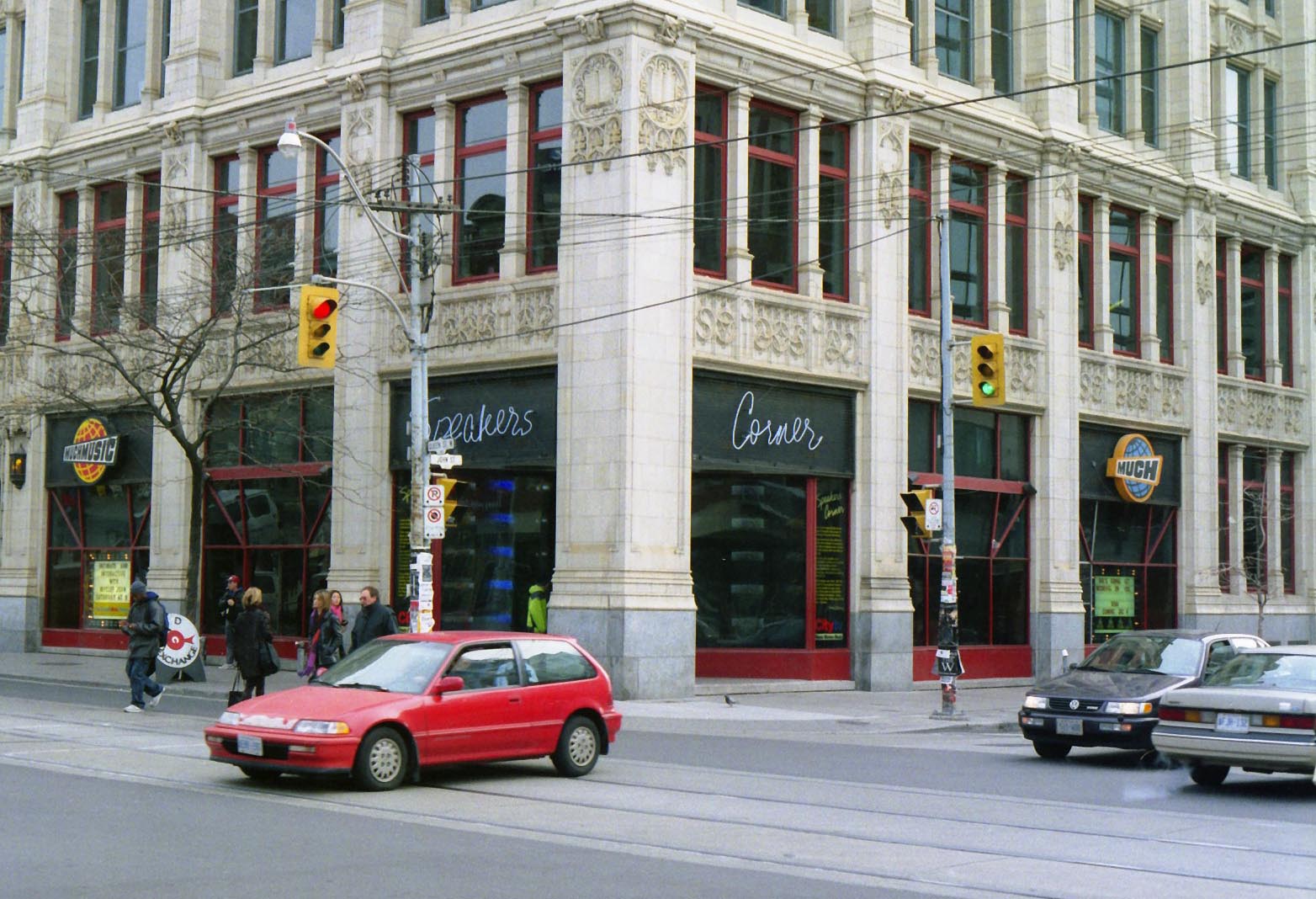
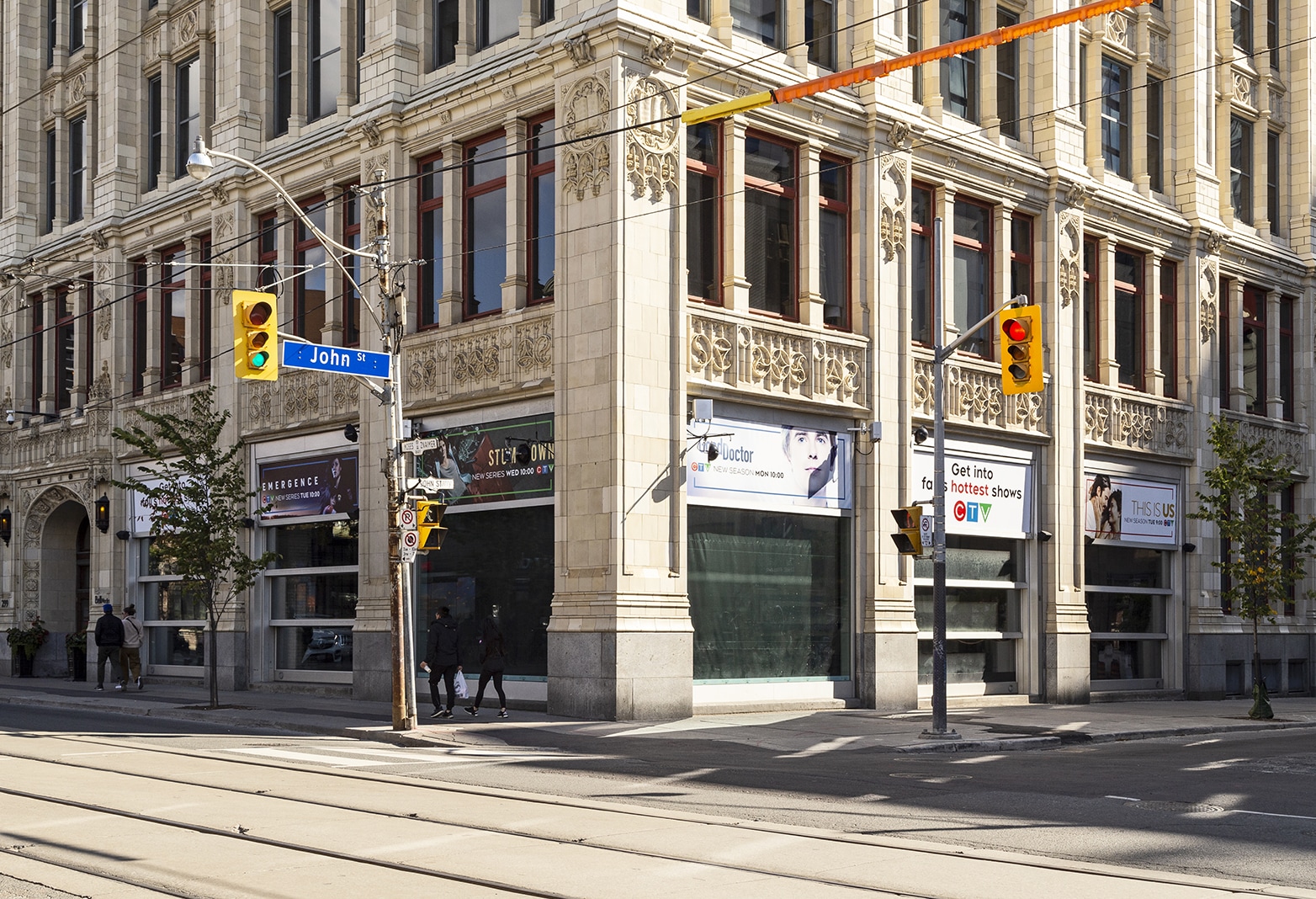
Click here to travel through time
See how the iconic MuchMusic building has changed from the 1980s to today.
Photograph by Ken Eckert, 2000. Licensed through Creative Commons.
Photograph by Vik Pahwa, 2019.
Dive Deeper
Christopher Ward. Is This Live?: Inside the Wild Early Years of MuchMusic: The Nation's Music Station. Toronto: Random House Canada, 2016.

